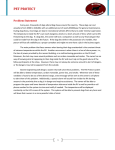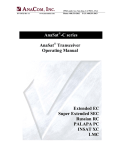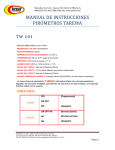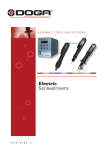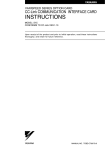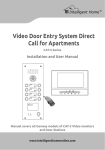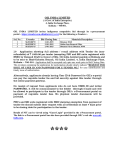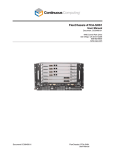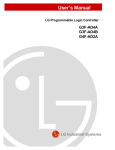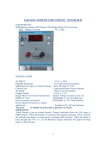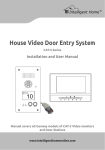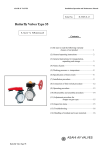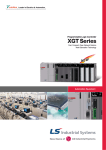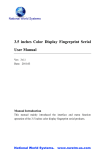Download User Manual
Transcript
Tension Controller – Feedback System TC-608P Control Panel (In the Form of a Load Cell) (Built-In communications Function) User Manual TENSION CONTROLLER KG RUN OUT ERR KG CATCH - + MODE SET LINK TC-608P Contents 1. Foreword 2. Attention 3. TC-608P Principles 4. TC-608P Features 5. Working Diagram 6. i. Put-In ii. Roll-Up Inspection of products i. Exterior ii. External Dimensions iii. Control Panel Display and Operating Directions 1. LED 2. Touch Key 7. Operating TC-608P 8. Installing i. Standard Specifications ii. Fastening Side of Controller, Terminal Connection and Control Panel Installing Dimensions 9. Wiring i. Terminal Functions ii. Terminal Connections 10. Parameters 11. List of Parameters 12. List of Communication Parameters 13. Indicating Output Status 14. Feedback Equipment 15. Control Equipment 16. Issues Needing Attention When Conducting Trials 17. Troubleshooting 1 1. Foreword Many thanks for choosing TC-608P Feedback-System Tension Controller (hereinafter referred to as 608P.) Read this user manual before using to take full advantage of 608P and for users’ safety. The manual tells you how to do the wiring, set parameters and detect abnormalities and deal with them. Keep the manual for future reference. Contact us in the event of questions to which answers cannot be found in the manual. We will do our utmost to offer you satisfactory solutions. Your comments are welcome anytime. 2. Attention: .No wiring and removing/installing connector of 608P when the power is on. .Terminals of 608P are contacts of feedback and output signals. Do not use them for other purposes. .Do not connect the output terminal of 608P to AC power or allow alien voltage to enter. .Do not remove the casing and conduct pressure-endurance tests on components. .Make sure the power input into terminals 1 and 2 to be AC 220V ±10%. 3. Principles The controller sets the material put-in and roll-up and the tension value required according to the actual production conditions. 608H adjusts the output command after comparing the settings with the value detected and returned by the Load Cell in order to change the braking force or the roll-up torque, automatically setting the actual tension to the preset tension, a high-precision tension control system. 4. Features: .high precision, high reliability .tension value may be set at: kg / N / LB by the user .may be directly connected to LOAD CELL for input; digitized zeroing and rate adjustment features for ease of operation. .digital design, unchanged characteristic .humanistic design, easy to operate .output command multi-functional display including preset and actual tension values .possess the features of accelerating and decelerating master speed and augmentative delayed time output .parameter power outage memory function .able to initiate augmentative function, able to compensate static friction arising from initiating machine .tension reduction function at shutdown eliminates excessive tension 2 5. Working Diagram .Put-in Motor Air Pressure Brake INV. E/P Magnetic Powder Brake Load cell VA-816 Electro Pneumatic INV. TC-608P .Roll-up Load cell INV. INV. TC-608P 3 Dc-Driver VA-816 Oil Pressure Motor Driver 6. Inspection of Products .Exterior Dimensions TENSION CONTROLLER KG RUN OUT ERR KG CATCH - + MODE SET LINK TC-608P .Back Panel Pins Pins 12-24 Back Cover Pins 4-11 Pins 1-3 Casing Dimensions: 96mm X 96 mm Opening Dimensions: 92 mm X 92 mm 4 ■ Control Panel and Operating Directions TENSION CONTROLLER Tension Display Operating Status Relay Output Abnormal Status OUT ERR Tracking Complete Manual VR Knob KG RUN KG CATCH - + MODE Setting Display SET LINK TC-608P Communication Status Set Change Decrease Parameter Parameter Increase ■ LED Signals: Upper-row LED display Specifies display of feedback value or output percentage through parameter 18 while the display is in regular display mode. Lower-row LED display Displays tension setting while the display is in regular display mode. RUN When the controller stops working, RUN goes off. When the controller begins working, RUN continues outputting. OUT When relaying output. CATCH When the INDEX feature is turned on, if INDEX error is within preset range (Pr.02), this light is lit to indicate completion of tracking. ERR When the system detects abnormalities, this light is lit. LINK (Optional) When RS-485 has external connection, each time a communication is completed, LINK flashes one time. 5 ■ Setting Parameters (Using press keys): MODE ▲ ▼ SET (1) <MODE>: The key is used to enter parameter display mode or return to regular display mode. Press once to enter parameter display mode. Press again to return to regular display mode. When inputting parameters, the Pr XX displayed at the bottom is parameter number, while the content of the parameter is displayed at the top. (2) <SET>: This key serves three purposes. When pressing <MODE> and <SET>, the Pr XX displayed at the bottom begins flashing, indicating entry into parameter change mode. After parameter change is completed, press <SET> to store changed value in the controller. If <SET> is not pressed before pressing <MODE> to exit, the parameter will remain unchanged. When in regular display mode, <SET> may be used to remove error status. (3) <▲>: After entry into parameter display mode, <▲> may be used to add one to parameter number. After entry into parameter change mode, <▲> may be used on <Lower-row Display Flash> to add one to parameter value. (4) <▼>: When in parameter display mode, <▼> may be used to deduct one from parameter number. When in parameter change mode, <▼> may be used on < Lower-row Display Flash > to deduct one from parameter value. 7. Operating TC-608H: Enter corresponding values used by the system’s Load Cell into internal parameters of 608H (see “Parameters” for details.) Press △ or ▽ on the control panel and enter the tension value needed. Or, set to “Manual” and use the control panel knob to enter the tension needed. (See “Terminals” and “Parameters” for applicable contacts’ functions and parameters.) 6 8. Electric Dimensions and Use Environment for Installation: Electric Dimensions and Standard Dimensions Voltage Electric Dimensions Standard Dimensions AC 220 V + 10%50/60HZ 1 set of LOAD CELL input 0-4 mV input, floating zeroing and magnifying 2 sets of AI (optional) DC 0-10V input, 12 bit resolution, input impedance 200K 1 set of AO (1 set optional) DC 0-10V output, max 10mA, 12 bit resolution 4 sets of DI Dry contact or crystal method mode (Low Active) 2 sets of RELAY DO Relay A contact 5A 250VAC/30VDC RS-485 MODBUS communication (optional) Communication adopts RS-485 interface MODBUS RTU protocol, output and read may be activated, revised, and specified through communication. Panel dimensions 96mmx96mm Opening dimensions 92mmx92mm Installation depth 150mm Weight 1kg and under Use Environment for Installation Environment 9. Site of use Indoors; no corrosive gases, fluids, and dust Operating temperature 0℃ to 60℃ Storing temperature 0℃ to 60℃ Humidity of surrounding environment 90% RH and under Wiring ■ Terminal code numbers and pins Serial # Name Function Description 1 AC1 AC 220V Power input (+10% error) 2 AC2 AC 220V Power input (+10% error) 3 FG FG Power grounding 4 V+ LOAD CELL +10V Connect LOAD CELL reference power supply + input 5 V- LOAD CELL 0V Connect LOAD CELL reference power supply - input 6 S+ LOAD CELL signal+ Connect LAOD CELL signal output + 7 S- LOAD CELL signal- Connect LAOD CELL signal output - 8 RY1C Relay1 COM contact 7 Serial # Name 9 RY1A Relay1 A contact 10 RY2C Relay2 COM contact 11 RY2A Relay2 A contact Parameter designation 5A AC250/DC35V 12 AI1 Analog input 0-10V Analog external feedback input 13 AI2 Analog input 0-10V Master speed input 14 ACOM ACOM Analog COMMON contact 15 +12V DC 12V Use of +12V power output analog setting 16 AOUT1 Analog output 1 Analog command output 0-10V 17 AOUT2 Reserved 18 INP1 External input contact 1 Operating started 19 INP2 External input contact 2 Tension reversion (manual/automatic) 20 INP3 External input contact 3 G1 plus % compensation 21 INP4 External input contact 4 G2 minus % compensation 22 ICOM Input contact COM Digital input contact COMMON 23 485+ RS - 485 + RS – 485 communication 24 485 - RS - 485 - RS – 485 communication Attention: Function Description Parameter designation 5A AC250/DC35V Input contact is a dry contact or NPN contact Configuration of terminals: 8 Wiring of terminals: input master speed analog output analog input communication connection variable resistor or external analog signals roll-up, put-in motors master motor Cylinder electro-pneumatic transducer magnetic magnetic particle brake, particle driver clutch tension feedback signals 10. Parameters Pr‧01 Setting password Description: Parameter password. The setting needs to be the same as 1234 before other parameters can be set. Range: 0-9999 Factory setting: 1234 Pr‧02 Setting maximum value Description: Setting the maximum value when adjusting tension setting on control panel (lower row). Range: 0.1-999.9 Factory setting: 100.0 Pr‧03 Setting minimum value Description: Setting the minimum value when adjusting tension setting on control panel (lower row). Range: 0.1-999.9 Factory setting: 100 9 Pr‧04 Feedback upper limit Description: When the feedback is greater than the setting, a feedback upper limit will be set, which can be used in conjunction with RELAY output. Range: 0-999.9 Factory setting: 90.0 Pr‧05 Feedback lower limit Description: When the feedback is greater than the setting, a feedback lower limit will be set, which can be used in conjunction with RELAY output. Range: -100.0-999.9 Factory setting: 0.1 Pr‧06 Insensitive area Description: When the error between the feedback and the setting falls below the parameter’s setting, corrective computation will terminate in order to avoid the instability caused by a minor error. Range: 0-25.5 Factory setting: 0.3 Pr.07 output voltage Basic torque Description: When input contact INP2 is ON, tension output will revert to basic torque output. If Pr.36 (source of basic torque) is set at 0 (designated by Pr.07), the parameter is able to set basic torque output value. Range: 0-10.00 (V) Factory setting: 1.00 (V) Pr‧08 Startup augmentation (%) Description: When INP1 operation is started, tension output will compensate startup augmentation first with compensation time set by Pr.09. Range: 0-255 (%) Factory setting: 20 (%) Pr‧09 Startup time Description: When INP1 operation is started, tension starts augmentation compensation time value. Computation begins from the instant INP1 is ON. Range: 0-25.5 (seconds) Factory setting: 0.5 (seconds) 10 Pr‧10 Axis acceleration augmentation (%) Description: When AI2 axis speed input detects acceleration, tension output will compensate for acceleration augmentation. Range: 0-255 (%) Factory setting: 20 (%) Pr‧11 Axis acceleration augmentation delay time Description: Once axis acceleration is over, delay time of acceleration augmentation may be set by this parameter. Range: 0-25.5 (seconds) Factory setting: 0.5 (seconds) Pr‧12 Axis deceleration augmentation (%) Description: When AI2 axis speed input detects deceleration, tension output will compensate for deceleration augmentation. Range: 0-255 (%) Factory setting: 20 (%) Pr‧13 Axis deceleration augmentation delay time Description: When axis deceleration is over, delay time of deceleration augmentation may be set by this parameter. Range: 0-25.5 (seconds) Factory setting: 0.5 (seconds) Pr‧14 Terminating augmentation (%) Description: When INP1 operation is OFF, tension output will compensate for the termination. Range: 0-255 (%) Factory setting: 20 (%) Pr‧15 Terminating movement time Description: When INP1 is OFF, tension terminates augmentation compensation time. The time begins from the moment INP1 is OFF. Range: 0-25.5 (seconds) Factory setting: 0.5 (seconds) Pr‧16 G1 contact augmentation value (+%) Description: When INP3 G1 compensation setting is ON, tension output will compensate G1 augmentation. The value is fixed at adding % augmentation. Range: 0-255 (%) Factory setting: 20 (%) 11 Pr‧17 G1 augmentation delay time Description: When INP3 G1 is OFF, this parameter is able to set delay termination compensation time. Range: 0-25.5 (seconds) Factory setting: 0.5 (seconds) Pr‧18 G2 contact augmentation value (-%) Description: When INP4 G2 compensation setting is ON, tension output will compensate for G2 augmentation. This value is fixed at deducting % augmentation. Range: 0-255 (%) Factory setting: 20 (%) Pr‧19 G2 augmentation delay time Description: When INP4 G2 is OFF, this parameter is able to set delay termination compensation time. Range: 0-25.5 (seconds) Factory setting: 0.5 (seconds) Pr‧20 Output minimum torque voltage Description: Regardless of the results of output computation, output shall not fall below this preset voltage. Range: 0-10.00 (V) Factory setting: 1.00 (V) Pr‧21 Output maximum torque voltage Description: Regardless of the results of output computation, output shall not exceed this preset voltage. Range: 0-10.00 (V) Factory setting: 10.00 (V) Pr‧22 Selecting work mode Description: Compensation direction varies as different work modes are selected. 0 = Put-in ; 1 = Roll-up Range: 0-1 Factory setting: 0 12 Pr‧233 Feedback zero drift (correcting ZERO) Description: When tension feedback reading zero is different the actual, this parameter may be used to move zero position forward and backward. Range: -9999-9999 Factory setting: 0 Pr‧243 Adjusting feedback rate (correcting rate SPAN) Description: When tension feedback reading is different the actual weight, this parameter may be used to adjust the rate. When using, zero shall be adjusted before adjusting rate. Range: 0.001- 9.999 Factory setting: 1.000 Pr‧253 Position of tension decimal point Description: This is used to set the position of tension display’s decimal point. Range: 0-3 Factory setting: 1 Pr‧263 Displaying average frequency Description: When tension displays, this parameter can be used to set average frequency in order to obtain more stable readings. Range: 1-255 Factory setting: 1 Pr‧27 Starting the minimum master speed voltage value of integral Description: When master speed (AI2) voltage is smaller than the setting, integral terminates. If integral is set at 0, it continues after startup. Otherwise, master speed is set at 0. Range: 0-10.00(V) Factory setting: 0.05 (V) Pr‧28 Segment 1 integral compensation rate (I1t segment 1 integral compensation time) Description: When error continues to be generated, this value can be used to set integral rate. The greater the value of setting is, the slower the speed of compensation and vice versa. Excessively small setting will lead to output vibration. 13 Range: 0.01-99.99 (seconds) Factory setting: 5.00 (seconds) Pr‧29 Segment 2 integral compensation rate (I2t segment 1 integral compensation time) Description: Integral can be computed in two steps. The parameter is segment 2 value. When using, segment 1 will be set at a greater rate (slower compensation), while segment 2 set at a small rate (faster compensation). Pr.30 is then used to determine the division point, which can achieve the effect of faster and steadier revision. Range: 0.01-99.99 (seconds) Factory setting: 1.00 (seconds) Pr‧30 The margin of error when using segment 1 integral (I revision) Description: This value is the margin of error when using segment 1. Use segment 1 when smaller than the margin of error, while using segment 2 when greater than the margin of error. Range: 0.1-999.9 Factory setting: 1.00 [Integral control output equation] I = ∑ (E ∆ It1) Integral control output = Total of past errors Example: When integral control time constant (∆ It1) is set at a greater value, within a fixed period of time T, the accumulated I value is smaller, and the output effect caused by I value is smaller, too. By the same token, When integral control time constant (∆ It1) is set at a smaller value, within a fixed period of time T, the accumulated I value is greater, and the output effect caused by I value is greater, too. Example: For an error response curve as shown below, when the error goes from 0 to 3 and back to 0, the integral value obtained varies due to different It settings. E Error value 3 Error value curve 2 1 14 0 T1 T2 T3 T4 T5 T6 Sec Time When It = 1 second, total integral I=∑ (E ∆1) is as follows: I = T1(E) + T2(E) + T3(E) + T4(E) + T5(E) + T6(E) = 1 + 2 + 3 + 2 + 1 + 0 = 9 When It = 0.5 second, total integral I=∑ (E ∆0.5) is as follows: I = T0.5(E) + T1(E) + T1.5(E) + T2(E) + T2.5(E) + T3(E) + T3.5(E) + T4(E) + T4.5(E) + T5(E) + T5.5(E) + T6(E) = 0.5 + 1 + 1.5 + 2 + 2.5 + 3 + 2.5 + 2 + 1.5 + 1 + 0.5 + 0 = 18 Pr‧31 Integral computation substitutes maximum error value Description: Integral is computed by substituting the error. When the error is greater, integral may be continuously substituted until an excessive value is accumulated. This parameter is adopted to place an upper limit on substitution error in order to prevent this situation from happening. Range: 0.1-999.9 Factory setting: 10.0 Pr‧32 Error correction percentage adjustment (P correction) Description: Basic percentage adjustment varies depending on the variation of error. The greater the setting is, the percentage relationship of greater percentage correction is obtained. Range: 0-99.99 Factory setting: 0 Example: P is used to directly correct error deviation. It also serves to inhibit excessive integral. Excessively great setting will result in vibration. [Integral control output equation] P = PK x E (error) Percentage control output value = percentage setting augmentation constant difference between setting and current value Error P=0.5 500 0 15 P=1.0 x 2.5V 5V Correction [Different output values corresponding to different PK percentage setting augmentation constants] Pr‧33 DK differential setting (D correction) Description: Differential control augmentation constant. Differential control is added to reduce the control system’s overshoot. “Brake” is applied to differential control in order for the control system to slow down before reaching the ideal position. D (differential control output value) = DK (integral control augmentation constant) x (∆E / ∆t) (rate of change of error) Range: 0-99. 99 Factory setting: 0 [Integral control output equation] D = DK * ∆E / ∆t Differential control output value = Differential augmentation * Rate of change of error Differential control is based on the variation within differential sampling time (∆t) to turn ∆E/∆t into output value. Example: DK = 1.00, D = 2 when T2. (2/1) x 1.00 = 2 E Error 4 ∆E=2 2 0 T T1 T2 Sec ∆T=1 Pr‧34 Decline percentage of differential per 0.1 second Description: The correction method of differential is of pulse type. Therefore, when error 16 stops changing, correction declines. This parameter sets the rate of decline. When the setting is large, the decline is slow; while when the setting is small, the decline is fast. Range: 0.1-0.99 Factory setting: 0.50 Pr‧35 Source of tension feedback Description: 0 = LOAD CELL; 1 = AI1 Range: 0-1 Factory setting: 0 Pr‧36 Source of basic torque setting Description: 0 = Pr.07; 1 = Control panel knob Range: 0-1 Factory setting: 0 Pr‧373 Display of the lower row Description: This parameter is used to display the value to be observed. Settings of the parameter are listed below: Range: 0-2 Factory setting: 0 Setting Display 0 Tension setting 1 Output value 2 Pr‧38 Master voltage speed MODBUS designated communication station number Description: When using the communication feature of MODBUS, an one and only station number for the machine can be set in order to distinguish between different controllers. Range: 1-255 Factory setting: 1 Pr‧39 MODBUS communication rate Description: When using communication, a certain rate can be designated as follows: 1 = 2400 17 2 = 4800 3 = 9600 4 = 19200 5 = 38400 Range: 1-5 Factory setting: 4 Pr‧40 MODBUS communication format Description: When using communication, the format may be designated as follows: 0 = N, 8, 2 1 = E, 8, 1 2 = N, 8, 1 Range: 0-2 Factory setting: 0 Pr‧41 RELAY1 output designation Description: RELAY1 may designate the output method: 1 = Start 2 = Feedback HI 3 = Feedback LOW 4 = Feedback NORMAL Range: 1-4 Factory setting: 2 Pr‧42 RELAY2 output designation Description: RELAY1 may designate the output method: 1 = Start 2 = Feedback HI 3 = Feedback LOW 4 = Feedback NORMAL Range: 1-4 Factory setting: 3 Pr‧43 Description: Range: 0-1 Selecting range of output voltage 0 = 0-10 V ; 1 = 0-5 V 18 Factory setting: 0 11. List of Parameters Serial Parameter Scope User Settings # 1 Set password 0000 - 9999 1234 2 Set maximum value 000.1- 999.9 100.0 3 Set minimum value 000.1- 999.9 100 4 Feedback upper limit 0000 - 999.9 90.0 5 Feedback lower limit -100.0-999.9 00.1 6 Insensitive area 000.0 -025.5 00.3 7 Basic output voltage 00.00- 10.00(V) 1.00 8 Initiate augmentation 0000 - 0255(%) 020 9 Initiate delay time 000.0 - 025.5(seconds) 00.5 10 Correct percentage when 0000 - 0255(%) 020 master speed increases 11 Correct delay time when 000.0 - 025.5(seconds) 00.5 master speed increases 12 Correct percentage when 0000 - 0255(%) 020 master speed decreases 13 Correct delay time when 000.0 - 025.5(seconds) 00.5 master speed decreases 14 Master speed stop correction 0000 - 0255(%) 020 percentage 15 Master speed stop correction 000.0 - 025.5(seconds) 00.5 delay time 16 G1 contact augmentation 0000 - 0255(%) value 19 020 Note 17 G1 augmentation delay time 000.0 - 025.5(seconds) 00.5 18 G2 contact augmentation 0000 - 0255(%) 020 value 19 G2 augmentation delay time 000.0 - 025.5(seconds) 00.5 20 Minimum output voltage 00.00- 10.00(V) 21 Maximum output voltage limit 00.00- 10.00(V) 10.00 22 Set roll-up, put-in 0000 - 0001 000 23 Feedback zero deviation -9999 - 9999 000 Scope User Settings 0.001 - 9.999 1.000 Serial Parameter 24 Feedback value rate 1.00 adjustment 25 Tension decimal point 0000 - 0003 001 26 Tension average time 0001 - 0255 001 27 Initiate integral’s minimum 0000 - 10.00(V) 00.5 master speed voltage value 28 Segment 1 integral 00.01 - 99.99(seconds) 5.00 compensation rate 29 Segment 2 integral 00.01 - 99.99(seconds) 1.00 compensation rate 30 Error scope of use of segment 000.1 - 999.9 1.00 1 integral 31 Integral computation 000.1 - 999.9 10.0 000.0 - 99.99 000 substitution maximum error value 32 Error correction percentage adjustment value 33 DK differential setting 000.0 - 99.99 000 34 Decline percentage of 000.1 – 00.99 0.50 differential per 0.1 second 35 Source of tension feedback 0000 - 0001 000 36 Initiate source of voltage 0000 - 0001 000 37 Display method of lower row 0000 – 0002 000 38 MODBUS communication 001 setting 0001 - 0255 20 Note address 39 Communication rate 0001 - 0005 004 40 MODBUS communication 0000 - 0002 000 0001 - 0004 002 0001 - 0004 003 Select scope of output voltage 0000 - 0001 000 format 41 RELAY 1 designated output method 42 RELAY 2 designated output method 43 12. List of Communication Parameters MODBUS communication description (0000): tension display value (0001): output voltage value (0002): error code (0003): tension setting (0004): Set maximum value (0005): Set minimum value (0006): feedback upper limit (0007): feedback lower limit (0008): insensitive area (0009): basic torque voltage (reversion) (0010): initiate augmentation (0011): initiation time (0012): axis acceleration augmentation (0013): master speed acceleration termination delay (X 0.1 second) (0014): axis deceleration augmentation (0015): master speed deceleration termination delay ( X 0.1 second) (0016): terminate augmentation (0017): termination time (0018): G1 contact augmentation value (+) (0019): G1 contact movement termination delay time (0020): G2 contact augmentation value (+) (0021): G2 contact movement termination delay time (0022): minimum output torque voltage (0023): maximum output torque voltage 21 13. Indicating Output Status: Machine operating ON OFF Acceleration Speed Deceleration Acceleration Termination Initiation Time Axis speed Initiation time Termination time Acceleration augmentation Deceleration augmentation Put-in output output Acceleration Acceleration Deceleration Endurance output Roll-up output Initiation Termination Endurance Time Initiation Acceleration Acceleration Endurance Deceleration Termination Endurance Time Initiation: Use Pr.8 to set initiation augmentation percentage and Pr.9 to set initiation augmentation time. Compensation direction will change depending on put-in or roll-up. Termination: Use Pr.14 to set correction compensation percentage and Pr.15 to set correction compensation time. Compensation direction will change depending on put-in or roll-up. Acceleration: Use Pr.10 to set acceleration augmentation percentage and Pr.11 to set acceleration augmentation time. Compensation direction will change depending on put-in or roll-up. Deceleration: Use Pr.12 to set deceleration augmentation percentage and Pr.13 to set deceleration augmentation time. Compensation direction will change depending on put-in or roll-up. 22 14. Feedback Equipment: 1. LOAD CELL: LOAD CELL detects material surface tension and relay signal to controller for calculation. 2. Dancer: Dancer detects position of roller or arm and relay signal to controller for calculation in order to control material tension. 3. Frequency converter: TC-608H may connect master motor frequency converter 0-10VDC output into master speed signal (AI2) in order to determine master acceleration/deceleration or stop, and assist in controlling material tension. 15. Control Equipment: 4. Magnetic powder brake: TC-608P analog output contact can be used to control put-in axis’s torque in order to achieve material surface tension control, to be used in passive put-in. 5. Electro-pneumatic converter: , Use cylinder to control put-in axis’s torque through TC-608P analog output contact in order to achieve material surface tension control, to be used in passive put-in. 6. Magnetic powder clutch: Through TC-608P analog output contact, speed may be fixed using roll-up axis’s motor. Material surface tension control can be achieved with magnetic powder brake controlling axis’s torque, to be used in roll-up. 7. Motor driver: A. Use TC-608P analog output contact and roll-up speed differential of roll-up axis’s motor to achieve material surface tension control, to be used in roll-up. B. Use TC-608P analog output contact and roll-up speed differential of put-in axis’s to achieve material surface tension control, to be used in power put-in. 16. Issues Needing Attention When Conducting Trials: 1. Please check wiring and parameter settings to make sure they are correct. 2. Calibrating and zeroing tension: A. Zeroing tension: After power is turned on, under the circumstance of zero load, check to see whether reading of controller’s upper row displays zero. If tension displays, please adjust Pr.23 to ZERO until reading displays zero. B. Calibrating tension: After tension is zeroed, please set Pr.24 (number of kilos corresponding to 10V) to total weight of LOAD CELL. Take a weight 23 (suggested weight is 1/2 or 1/5 of total weight of LOAD CELL). Fasten it with a rope. Pass the rope through simulation material’s actual route. Fasten front end of weight to front end of LOAD CELL. Allow back end of LOAD CELL to droop in order to create tension. Check to see value displayed on upper row of controller is the weight of the weight. If the value is different from tension displayed, please adjust SPAN of Pr.24 until displayed value is the same as the weight’s weight. (See illustration below.) fastening end weight 3. TC-608P may obtain feedback solely from LOAD CELL (AI1), without having to refer to master speed signal (AI2) before conducting tension control. If above control methods are needed, adjust Pr.27 (initiating integral correction minimum master speed voltage) to 10V. 4. If contacts (16- VOUT analog output+) and (17- VCOM analog output-) voltage output move in opposite directions (such as material tension becomes larger or smaller), please check the setting for Pr.22 (setting roll-up/put-in) is correct. 17. Troubleshooting: 1. TC-608P cannot calculate: a. Please check RUN to see if it is lit. If RUN flashes, please check contacts (18-IP1 initiating contact) and (22-ICOM control contact common contact) to see whether they are short-circuited. b. Please check LOAD CELL feedback to see whether there is voltage input. If there is no voltage input, please check loudspeaker and LOAD CELL to see whether output is normal. c. Please check Pr.21. voltage value to see whether the setting is so small that 24 output voltage is limited to the extent that it cannot reach the output voltage needed. 25



























